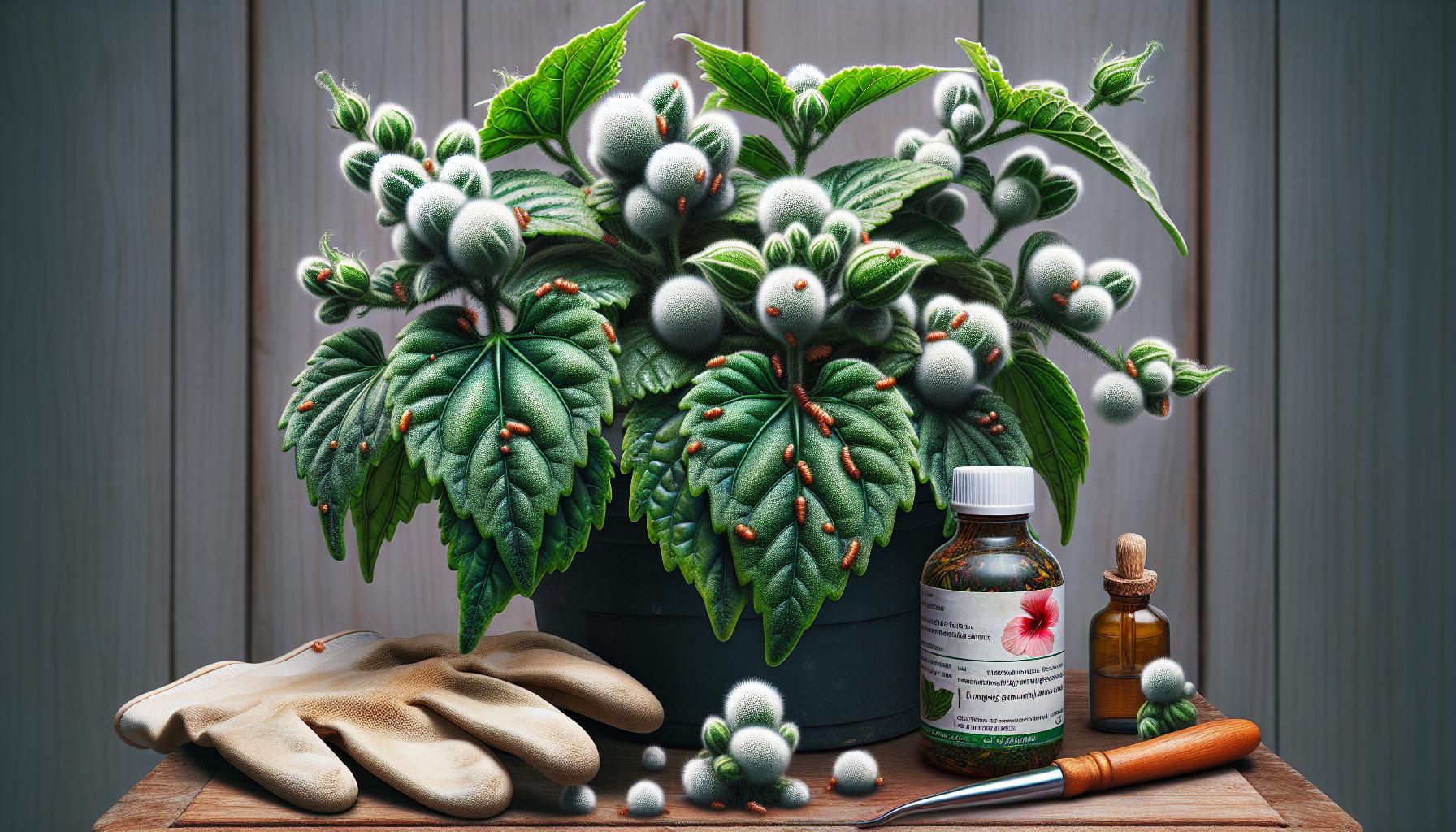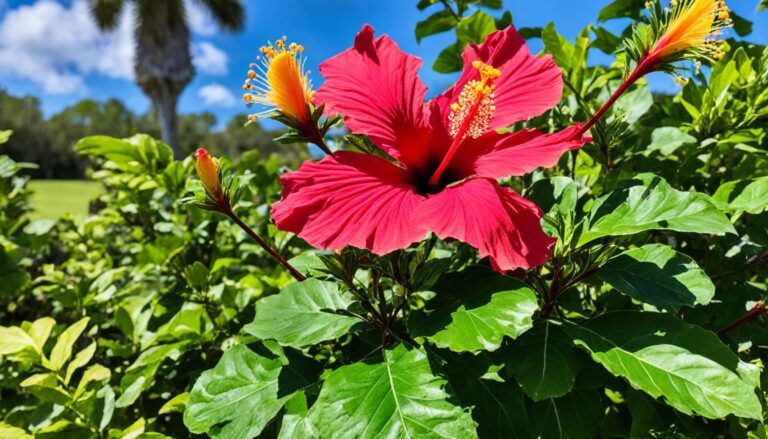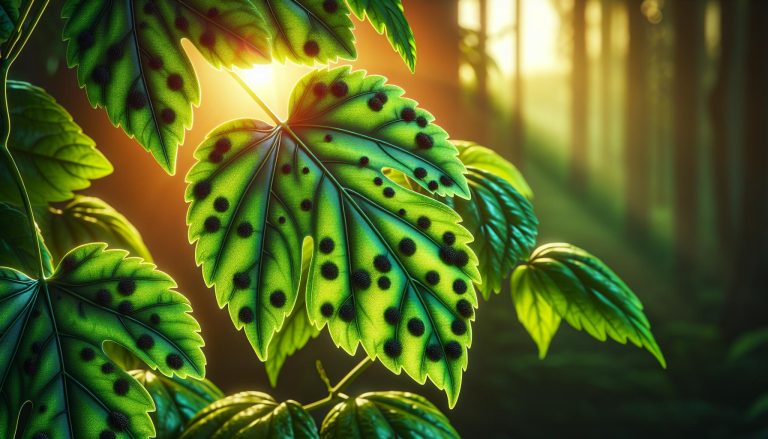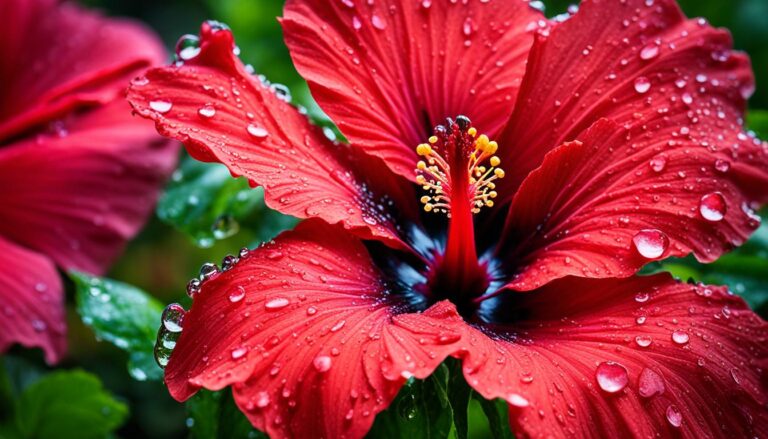Mealybugs on Hibiscus: Natural and Chemical Solutions for Pest-Free Plants
As a passionate gardener, I’ve encountered my fair share of plant pests, but few are as persistent as mealybugs on hibiscus. These tiny, cotton-like creatures can quickly infest your beautiful hibiscus plants, sucking the life out of them and leaving behind a sticky mess. But don’t worry, there’s hope!
Did you know that a single female mealybug can lay up to 600 eggs in her lifetime? That’s why it’s crucial to address this problem early on. In this article, I’ll share my expert tips on identifying, preventing, and treating mealybug infestations on your hibiscus plants. Whether you’re a seasoned gardener or a novice plant enthusiast, you’ll find valuable information to keep your hibiscus thriving and mealybug-free.
What Are Mealybugs?
Mealybugs are small, soft-bodied insects that belong to the Pseudococcidae family. These pests are common plant parasites that feed on the sap of various plants, including hibiscus.
Identifying Mealybugs on Hibiscus
Mealybugs on hibiscus appear as tiny, oval-shaped insects covered in a white, waxy substance. They’re typically found in clusters on stems, leaves, and flower buds. Here are key characteristics to look for:
- Size: 1/10 to 1/4 inch long
- Color: White or light gray
- Texture: Cottony or fuzzy appearance
- Location: Often hidden in leaf axils or under leaves
- Movement: Slow-moving or stationary
I’ve observed that mealybugs tend to congregate in protected areas of the hibiscus plant, such as where leaves join the stem or in the creases of flower buds. Their waxy coating serves as a protective barrier, making them resistant to some pesticides and environmental factors.
Female mealybugs lay 300-600 eggs in a cottony egg sac, which can often be mistaken for fungal growth. The eggs hatch within 1-3 weeks, depending on environmental conditions. Nymphs, or “crawlers,” emerge and spread to other parts of the plant or nearby plants.
To confirm a mealybug infestation on your hibiscus, gently wipe the suspected areas with a cotton swab dipped in rubbing alcohol. If it’s mealybugs, you’ll see a reddish-brown stain on the swab.
The Impact of Mealybugs on Hibiscus Plants
Mealybugs wreak havoc on hibiscus plants, causing significant damage to their health and appearance. These pests attack various parts of the plant, including leaves, stems, and flowers, leading to a range of detrimental effects.
Leaf Damage
Mealybugs feed on hibiscus leaves, extracting vital nutrients and sap. This feeding activity results in:
- Yellowing and distortion of leaves
- Premature leaf drop
- Stunted growth of new foliage
The loss of healthy leaves diminishes the plant’s ability to photosynthesize, weakening its overall vigor.
Stem and Bud Infestation
Mealybugs often congregate on stems and flower buds, causing:
- Reduced flower production
- Deformed or aborted buds
- Weakened stem structure
These effects not only impact the plant’s aesthetic appeal but also its ability to produce vibrant blooms.
Honeydew Secretion
As mealybugs feed, they excrete a sticky substance called honeydew. This secretion leads to:
- Attraction of ants, which protect mealybugs from natural predators
- Growth of sooty mold fungi on leaves and stems
- Reduced photosynthesis due to mold coverage
The presence of honeydew and sooty mold further compromises the plant’s health and appearance.
Systemic Weakening
Severe mealybug infestations can cause systemic issues in hibiscus plants:
- Reduced overall plant vigor
- Increased susceptibility to other pests and diseases
- Potential plant death in extreme cases
Left unchecked, mealybugs can significantly shorten the lifespan of hibiscus plants.
Economic Impact
For commercial growers and nurseries, mealybug infestations can have severe economic consequences:
| Impact | Percentage |
|---|---|
| Reduced plant sales | Up to 50% |
| Increased pesticide costs | 30-40% |
| Labor costs for treatment | 20-30% |
These figures underscore the importance of early detection and effective management strategies to mitigate the impact of mealybugs on hibiscus plants.
Signs of Mealybug Infestation
Identifying a mealybug infestation on hibiscus plants early is crucial for effective control. Here are the key signs to look out for:
- White, cottony masses: Small, fuzzy white clusters on leaves, stems, and flowers.
- Sticky residue: Honeydew secretions on leaves and surrounding surfaces.
- Leaf discoloration: Yellowing or browning of leaves, particularly along the veins.
- Distorted growth: Misshapen leaves, buds, or stems.
- Premature leaf drop: Excessive shedding of leaves, especially new growth.
I’ve observed that mealybugs often congregate in leaf axils, undersides of leaves, and around flower buds. These pests are typically 1/10 to 1/4 inch long and oval-shaped. Female mealybugs are wingless, while males have wings but are rarely seen.
To detect mealybugs early, I recommend inspecting hibiscus plants regularly, focusing on:
- New growth
- Leaf undersides
- Stem joints
- Flower buds
Early detection allows for prompt treatment, preventing severe damage to hibiscus plants and reducing the risk of widespread infestation.
Natural Methods to Control Mealybugs
Natural methods offer effective and environmentally friendly ways to control mealybugs on hibiscus plants. These approaches harness nature’s own defenses and utilize non-toxic substances to combat infestations.
Biological Control Options
Biological control is a powerful tool in the fight against mealybugs. I’ve found several natural predators that effectively keep mealybug populations in check:
- Ladybugs: These colorful beetles voraciously consume mealybugs, with some species capable of eating up to 5,000 mealybugs in their lifetime.
- Lacewings: Both adults and larvae feed on mealybugs, with larvae consuming up to 200 mealybugs per week.
- Mealybug destroyers: These small beetles specialize in mealybug control, with larvae eating up to 250 mealybugs during development.
- Parasitic wasps: Tiny wasps like Anagyrus pseudococci lay eggs inside mealybugs, killing them as their larvae develop.
To attract these beneficial insects, I plant nectar-rich flowers like marigolds, cosmos, and sweet alyssum near my hibiscus. Creating a diverse garden ecosystem naturally supports these mealybug predators.
Neem Oil Applications
Neem oil is a potent, natural insecticide derived from the neem tree. Here’s how I use it to combat mealybugs:
- Mix 2 teaspoons of neem oil with 1 quart of water and a few drops of mild dish soap.
- Spray the solution directly on mealybugs and affected plant areas.
- Apply weekly for 3-4 weeks to break the mealybug life cycle.
Neem oil disrupts mealybug feeding and reproduction, effectively controlling populations without harming beneficial insects. It’s also safe for use on edible plants, making it an ideal choice for organic gardeners.
Insecticidal Soap Treatments
Insecticidal soaps offer another natural, low-toxicity option for mealybug control. These soaps work by breaking down the waxy coating on mealybugs, causing dehydration. To use:
- Purchase a ready-made insecticidal soap or mix 1 tablespoon of mild liquid soap with 1 quart of water.
- Test on a small area of the plant to ensure no adverse reactions.
- Spray thoroughly, covering all plant surfaces, especially leaf undersides and crevices.
- Repeat applications every 7-10 days until mealybugs are eliminated.
For heavy infestations, I combine insecticidal soap treatments with manual removal using a cotton swab dipped in rubbing alcohol to target individual mealybugs.
Chemical Solutions for Mealybug Removal
When natural methods prove insufficient, chemical solutions offer effective alternatives for mealybug control on hibiscus plants. Here are some chemical options to consider:
Systemic Insecticides
Systemic insecticides provide long-lasting protection against mealybugs:
- Imidacloprid: A common systemic insecticide that’s absorbed by the plant and distributed throughout its tissues.
- Dinotefuran: Another systemic option that’s particularly effective against sap-sucking insects like mealybugs.
- Acetamiprid: This neonicotinoid insecticide offers both systemic and contact action against mealybugs.
Apply these products to the soil around the hibiscus plant, following the manufacturer’s instructions for dosage and frequency.
Contact Insecticides
For quicker results, contact insecticides directly target mealybugs on the plant’s surface:
- Malathion: An organophosphate insecticide that’s effective against a wide range of pests, including mealybugs.
- Permethrin: A synthetic pyrethroid that provides rapid knockdown of mealybugs.
- Bifenthrin: Another pyrethroid insecticide that offers residual control of mealybugs.
Spray these products directly on the affected areas of the hibiscus plant, ensuring thorough coverage.
Horticultural Oils
Refined horticultural oils provide a less toxic alternative to traditional insecticides:
- Mineral oil: Smothers mealybugs and their eggs, disrupting their respiratory system.
- Paraffinic oil: Similar to mineral oil but with a higher purity level, reducing the risk of plant damage.
- Neem oil: While mentioned in natural methods, it’s worth noting its dual action as both a repellent and a growth regulator.
Apply these oils as a foliar spray, covering both the upper and lower surfaces of leaves.
Safety Precautions
When using chemical solutions:
- Wear protective gear (gloves, goggles, and a mask) during application.
- Apply products in the early morning or late evening to minimize impact on beneficial insects.
- Avoid spraying on windy days or when rain is expected within 24 hours.
- Rotate between different chemical classes to prevent resistance development in mealybug populations.
By incorporating these chemical solutions into your mealybug management strategy, you’ll have a comprehensive approach to protecting your hibiscus plants from these persistent pests.
Preventing Mealybug Infestations on Hibiscus
Proper Plant Care
I’ve found that maintaining healthy hibiscus plants is crucial for preventing mealybug infestations. Regularly water hibiscus, ensuring the soil stays moist but not waterlogged. Fertilize plants monthly during the growing season with a balanced, water-soluble fertilizer. Prune hibiscus annually to promote air circulation and remove potential mealybug hiding spots.
Regular Inspection
I perform weekly inspections of my hibiscus plants, focusing on the undersides of leaves, stem joints, and new growth areas. Early detection of mealybugs allows for swift action, preventing widespread infestation. I use a magnifying glass to spot tiny nymphs and eggs that are often overlooked.
Quarantine New Plants
When introducing new plants to my garden, I always quarantine them for 2-3 weeks. This practice helps prevent the spread of mealybugs and other pests to existing hibiscus plants. During quarantine, I thoroughly inspect new plants and treat any signs of infestation before integrating them into the garden.
Natural Predators
I encourage natural predators of mealybugs in my garden. Ladybugs, lacewings, and parasitic wasps are effective in controlling mealybug populations. I plant nectar-rich flowers like marigolds and sweet alyssum near hibiscus to attract these beneficial insects.
Proper Watering Techniques
Overwatering can create a favorable environment for mealybugs. I water hibiscus plants at the base, avoiding wetting the foliage. This practice reduces humidity around the plant, making it less attractive to mealybugs. I also ensure proper drainage in pots and garden beds to prevent water accumulation.
Neem Oil Applications
I apply neem oil to my hibiscus plants every 7-14 days as a preventive measure. Neem oil acts as a natural repellent for mealybugs and other pests. I mix 2 tablespoons of neem oil with 1 gallon of water and spray the solution on all plant surfaces, including the undersides of leaves.
Pruning and Sanitation
Regular pruning helps maintain plant health and removes potential mealybug hiding spots. I prune hibiscus plants in early spring, removing dead or diseased branches. After pruning, I clean my tools with rubbing alcohol to prevent the spread of pests or diseases between plants.
Maintaining Healthy Hibiscus Plants
Proper Watering Techniques
Proper watering is crucial for hibiscus health. I water deeply but infrequently, allowing the soil to dry slightly between waterings. This practice prevents overwatering, which can lead to root rot and attract pests like mealybugs. I use a moisture meter to ensure optimal soil moisture levels, typically watering when the top 1-2 inches of soil feel dry to the touch.
Nutrient Management
Balanced nutrition is key to hibiscus vigor. I fertilize monthly during the growing season with a high-potassium, low-nitrogen fertilizer specifically formulated for hibiscus. This nutrient balance promotes healthy growth without excessive foliage that can attract mealybugs. I avoid over-fertilizing, as it can stress the plant and make it more susceptible to pest infestations.
Pruning and Shaping
Regular pruning maintains hibiscus health and appearance. I prune in early spring to remove dead or diseased branches, encourage new growth, and improve air circulation. When shaping, I use clean, sharp tools to make clean cuts at 45-degree angles just above leaf nodes. This practice reduces stress on the plant and minimizes potential entry points for pests and diseases.
Soil and Mulching
Well-draining soil is essential for hibiscus roots. I use a mix of peat moss, perlite, and compost to create an ideal growing medium. Mulching with organic materials like bark chips or coconut coir helps retain moisture, regulate soil temperature, and suppress weed growth. I maintain a 2-3 inch layer of mulch, keeping it away from the plant’s stem to prevent moisture buildup and potential pest habitation.
Environmental Considerations
Hibiscus thrive in specific conditions. I provide full sun to partial shade, depending on the climate, ensuring at least 6 hours of direct sunlight daily. In hot regions, I offer afternoon shade to prevent leaf scorch. I maintain temperatures between 60-90°F (15-32°C) and humidity levels around 50-60% for optimal growth. During winter, I move potted hibiscus indoors or provide frost protection for outdoor plants.
Pest Monitoring and Prevention
Vigilant pest monitoring is crucial. I inspect hibiscus plants weekly, examining leaves, stems, and buds for signs of mealybugs or other pests. I use sticky traps to detect early infestations and immediately isolate affected plants. As a preventive measure, I spray neem oil solution monthly, focusing on leaf undersides and branch joints where mealybugs often hide.
Conclusion
Tackling mealybugs on hibiscus requires a multi-faceted approach. From natural remedies to chemical solutions there’s a range of effective options available. Prevention is key and maintaining plant health through proper care practices is crucial.
By implementing the strategies I’ve outlined you’ll be well-equipped to protect your hibiscus from mealybug infestations. Remember regular monitoring and swift action are your best defenses. With patience and persistence you can keep your hibiscus thriving and mealybug-free.







